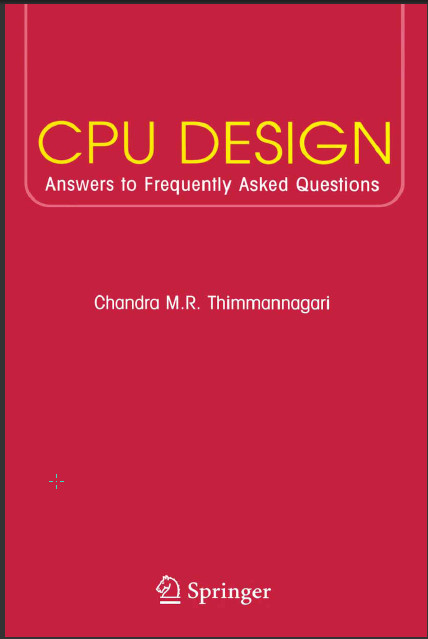資料介紹
I am honored to write the foreword for Chandra Thimmannagari’s book on CPU
design. Chandra’s book provides a practical overview of Microprocessor and high
end ASIC design as practiced today. It is a valuable addition to the literature on CPU
design, and is made possible by Chandra’s unique combination of extensive hands-on
CPU design experience at companies such as AMD and Sun Microsystems and a
passion for writing.
Technical books related to CPU design are almost always written by researchers in
academia or industry and tend to pick one area, CPU architecture/Bus architecture/
CMOS design that is the area of expertise of the author, and present that in great
detail. Such books are of great value to students and practitioners in that area.
However, engineers working on CPU design need to develop an understanding of
areas outside their own to be effective. CPU design is a multi dimensional problem
and one dimensional optimization is often counterproductive.
For instance, as someone who mainly does CPU architecture, I have found that CPU
architects who understand how logic design, circuit design and chip integration are
really done in practice do a much better job architecting the chip. There are
constraints in these different areas that could make an architectural idea hard to
implement, and an architect who understands these constraints is more likely to make
the right decisions upfront. However, there are really no books out there to help an
architect understand quickly how the later stages of chip design work. Reading
detailed technical books on physical design to obtain this knowledge is typically not
an option given time constraints. The most accessible way today to learn the broader
skill set necessary is from chatting with friends and picking up bits of knowledge
here and there. Over time the good ones do develop a working knowledge of all areas
of CPU design, but it takes many years.
The same goes for circuit designers who want to understand architecture. I have had
several circuit engineers come to me wanting to know more about architecture. I
answer questions as time permits and suggest they read “Hennessy and Patterson”. Ithelps, but goes only so far even though H&P is a really well written book. There is
just too much detail, and it is hard to filter out what is relevant.
In a way Chandra’s book is structured as a chat with a knowledgeable friend with
much time to spare. So we could imagine a circuit designer who is working on a
cache, and has a design problem - for instance, the replacement algorithm he is trying
to implement is not making timing. He will have to discuss this with the logic owner
or architect, but it will help if he has an understanding of the architectural options
available and any potential circuit issues with those options prior to the discussion.
He could look up this book and starting with the first question on caches (Q5 in
Architecture: What is cache memory in a CPU and what are the most common terms
associated with caches?) work through replacement policy related questions (Q10 to
Q15 in Architecture) to develop an understanding of the options available. Or
imagine an architect who is told that the particular idea she has in mind cannot be
implemented owing to routing density issues related to noise. She could look up the
relevant question in the book (Q6 in Circuits and Layout: What do you mean by
effect of noise in a design and what are the most common techniques used to reduce
its effect?) to develop a quick understanding of noise issues as well as possible
solutions and work with designers to find a way to implement her idea.
The book also provides excellent lists of techniques in the experienced logic/circuit
designer’s toolbox to attack a problem. For instance, a logic designer who is trying to
figure out how to make timing for a block could go straight to Q4 in the Logic
chapter and look at the list of suggestions there for fixing timing paths and start
making headway. Or a designer who is trying to reduce power for a block or a chip
could go to Q6 in the Logic chapter and look at the list of suggestions there for
reducing power. Or a circuit designer who is trying to fix noise problems could go to
Q6 in the Circuits and Layout chapter. Or a manager who wants to learn about design
tools available for a particular task could go to the relevant question in the Tools
chapter.
The book also includes good, concise descriptions of many thorny issues in CPU
design such as RAS, electromigration, IR drop, pass gate muxes and mintime fixes.
I believe the book will be a valuable addition to any CPU designer’s library.

- C2000常見問題解答
- Keystone EDMA常見問題解答
- Keystone NDK常見問題解答
- TFPxxx常見問題解答
- RS-232常見問題解答
- TMP LM 75比較常見問題解答
- CLOCK常見問題解答
- 隔離、iCoupler技術(shù)和iCoupler產(chǎn)品常見問題解答
- PN7160常見問題解答
- PDIUSBD12常見問題解答資料下載 11次下載
- AN-1291:數(shù)字電位計:常見問題解答
- PC 音質(zhì)常見問題解答
- 工業(yè)應(yīng)用Sigma-Delta ADC常見問題解答
- TOPSwitch-HX常見問題解答
- VxWorks常見問題解答
- 防水試驗機常見問題解答與故障排除方法 122次閱讀
- 電路設(shè)計常見問題解答 523次閱讀
- AWG和BERT常見問題解答 744次閱讀
- Ubuntu系統(tǒng)常見問題及解答 1306次閱讀
- USB集線器常見問題解答 1153次閱讀
- 單片機常見問題的解決思路和解決辦法 2480次閱讀
- 關(guān)于路由器的常見問題解答 2331次閱讀
- RS-485收發(fā)器常見問題解答 1322次閱讀
- Revit版Twinmotion常見問題解答 2071次閱讀
- 電流傳感器IC相關(guān)問題解答 3046次閱讀
- PCB設(shè)計技巧的常見問題解答 1917次閱讀
- 模擬技術(shù)常見問題解答 1918次閱讀
- 頻譜分析儀六大常見問題解答 2116次閱讀
- 常見問題解答:Xilinx采用首個ASIC級UltraScale可編程架構(gòu) 2370次閱讀
- 差分放大器AD813x常見問題解答 1w次閱讀
下載排行
本周
- 1常用電子元器件集錦
- 1.72 MB | 24471次下載 | 免費
- 2EMC電路設(shè)計工程師必備的EMC基礎(chǔ)
- 0.42 MB | 4次下載 | 2 積分
- 3低壓降肖特基整流管SR340L數(shù)據(jù)手冊
- 0.78 MB | 1次下載 | 免費
- 4CPCI6310型復(fù)合視頻采集板資料
- 0.04 MB | 1次下載 | 免費
- 5HT8 半橋電磁爐MCU應(yīng)用須知
- 1.91 MB | 次下載 | 免費
- 6快恢復(fù)二極管1F1 THRU 1F7數(shù)據(jù)手冊
- 0.95 MB | 次下載 | 免費
- 7高效率整流二極管HER601 THRU HER608數(shù)據(jù)手冊
- 0.53 MB | 次下載 | 免費
- 8橫河WT5000高精度功率分析儀產(chǎn)品資料_中文說明書_科瑞杰
- 1.60 MB | 次下載 | 免費
本月
- 1常用電子元器件集錦
- 1.72 MB | 24471次下載 | 免費
- 2三相逆變主電路的原理圖和PCB資料合集免費下載
- 27.35 MB | 111次下載 | 1 積分
- 3運算放大器基本電路中文資料
- 1.30 MB | 16次下載 | 免費
- 4蘋果iphone 11電路原理圖
- 4.98 MB | 11次下載 | 5 積分
- 5TL494工業(yè)用開關(guān)電源原理圖資料
- 0.22 MB | 10次下載 | 1 積分
- 6常用電子元器件介紹
- 3.21 MB | 8次下載 | 免費
- 7QW2893應(yīng)急燈專用檢測芯片
- 590.40 KB | 4次下載 | 免費
- 8EMC電路設(shè)計工程師必備的EMC基礎(chǔ)
- 0.42 MB | 4次下載 | 2 積分
總榜
- 1matlab軟件下載入口
- 未知 | 935130次下載 | 10 積分
- 2開源硬件-PMP21529.1-4 開關(guān)降壓/升壓雙向直流/直流轉(zhuǎn)換器 PCB layout 設(shè)計
- 1.48MB | 420064次下載 | 10 積分
- 3Altium DXP2002下載入口
- 未知 | 233089次下載 | 10 積分
- 4電路仿真軟件multisim 10.0免費下載
- 340992 | 191390次下載 | 10 積分
- 5十天學(xué)會AVR單片機與C語言視頻教程 下載
- 158M | 183344次下載 | 10 積分
- 6labview8.5下載
- 未知 | 81591次下載 | 10 積分
- 7Keil工具MDK-Arm免費下載
- 0.02 MB | 73815次下載 | 10 積分
- 8LabVIEW 8.6下載
- 未知 | 65989次下載 | 10 積分
 電子發(fā)燒友App
電子發(fā)燒友App

















 創(chuàng)作
創(chuàng)作 發(fā)文章
發(fā)文章 發(fā)帖
發(fā)帖  提問
提問  發(fā)資料
發(fā)資料 發(fā)視頻
發(fā)視頻 上傳資料賺積分
上傳資料賺積分









評論